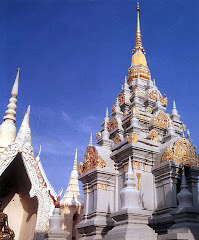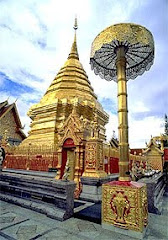Painting
Classical Thai painting was confined to temple and palace interiors and book illustrations. Mural painting was developed to a high degree in the belief that walls should enhance the beauty of the religious and royal objects they surrounded.
Traditional Thai painting was typically Asian in that conventional perspective was ignored and figures were large or small depending on their importance. Shadows were unknown and space was neutral rather than atmospheric.Figures were two dimensional and landscapes were merely sketchilytreated
backdrops for detailed action. A technique of pictorial composition called “apportioning areas” was employed, comparable to the “bird’ s eye view”of Western painting.
By this method, the positions
of the key scenes were assigned first and then closed off with “space transformers” that effectivelyisolated them from considerations of perspective by doing away with any surrounding intermediate ormiddle ground.
The traditional Thai painter had five primary pigments, the close equivalent of scarlet lake,yellow ochre, ultramarine blue, pipe clay-white, and pot-black. With these he was able to produce many other colours. All were tempera colours, finely ground powders that were stirred into bowls containing a glue binder, using sticks to work it to the desired strength and consistency. With these colours the traditional artists created uniquely beautiful compositions in the form of temple murals, cloth banners, and manuscript illustrations.
The earliest surviving murals are characterized by earth colours made from natural pigments. They depicted excerpts from the Jataka stories, episodes from the Buddha’s life, scenes of Buddhist heaven and hell, rows of gods, and scenes of contemporary Thai life. The murals in
The traditional painting technique continued into the
old subdued earth colours.
Noted Thai painters of today are sometimes recognized and awarded the status of “National Artist.” Among those who have achieved this distinction are Fua Hariphitak, Chalerm Nakeeraksa, Sanit Dispandha, and Tawee Nanthakwang.
credit : opm.go.th
photo: thaitravel.info
Technorati tags : Mural painting /thai painting /Wat Suthat /Thailand Temple /Bangkok /Buddhist /Wat










1 comment:
Thank you for this well-documented article. Nice pix too...
Post a Comment